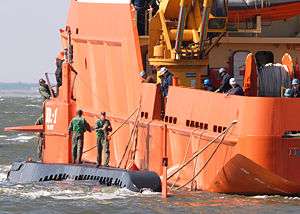MV Carolyn Chouest
MV Carolyn Chouest is a chartered submarine support ship for the United States Navy assigned to the Special Missions Program to support NR-1, the deep submergence craft. She towed NR-1 between work areas, served as a floating supply warehouse and provided quarters for extra crew until the NR-1 was removed from service in 2008.
 MV Carolyn Chouest with NR-1. | |
| History | |
|---|---|
| Name: | Carolyn Chouest |
| Owner: | Edison Chouest Offshore[1] |
| Builder: | North American Shipbuilding |
| In service: | 1994 |
| Identification: |
|
| Status: | Currently in service |
| Notes: | Leased to the Military Sealift Command (MSC), contractor operated and controlled |
| General characteristics | |
| Type: | ocean surveillance ship |
| Displacement: | 1599 tons |
| Length: | 238 ft (73 m) |
| Beam: | 52 ft (16 m) |
| Draft: | 17 ft (5.2 m) |
| Installed power: | 2 × 12-cylinder Caterpillar diesel engines 10,800 hp (8,100 kW) |
| Propulsion: | two Kort Nozzle variable-pitch propellers |
| Speed: | 17 knots (31 km/h; 20 mph) |
Operational history
In 1995, Dr. Robert Ballard used the Carolyn Chouest and its sub the NR-1, to explore the wreck of HMHS Britannic, the sister ship of RMS Titanic, which sank off the coast of Greece while serving as a hospital ship during World War I.[2]
November 1999, Carolyn Chouest assisted recovery efforts after the EgyptAir Flight 990 airplane crash 60 miles (97 km) south of Nantucket, Massachusetts. She provided underwater mapping of the debris field using the side-scan sonar and recorded underwater video of the site with the ROV Magnum.[3]
February 2002, NR-1 and Carolyn Chouest helped archeologists to chart the USS Monitor, the Navy's first ironclad warship, as she rests 250 feet (76 m) below the sea.[4]
October 2004, Carolyn Chouest helped tow HMCS Chicoutimi back to Faslane, after a fire on board the Canadian submarine killed one crewman and injured two, 100 miles (160 km) off Ireland.[5]
December 2006, the fast-attack submarine, USS Pittsburgh resurfaced during sea trials after a 25-year-old Portsmouth Naval Shipyard employee began having neurological problems. He was safely transferred to Carolyn Chouest and continued to receive treatment from Pittsburgh's corpsman until evacuated by a Coast Guard helicopter.[6]
March 2007, NR-1 and Carolyn Chouest under the direction of oceanographer Robert Ballard began mapping the Flower Garden Banks National Marine Sanctuary to help scientists determine where early Americans might have lived when, at the height of the last ice age, sea levels were nearly 400 feet (120 m) lower than they are today.[7]
References
- "Chouest". GlobalSecurity.org. Retrieved 2012-09-28.
- Ballard, Robert (28 January 1997). "Titanic's Lost Sister". PBS Nova. Retrieved 2014-02-13.
- Rising, David (20 November 1999). "Robot Maps Wreckage In Crash Area". The Seattle Times. Associated Press. Retrieved 2008-10-14.
- Bilyeu, Braden, JO3 (May 2002). "Carolyn Chouest and NR-1 explore naval history". Military Sealift Command. Retrieved 2008-10-14.
- "Submarine crew back on dry land". BBC News. 11 October 2004. Retrieved 2008-10-14.
- "Submarine Crewman Medevaced". Coast Guard News. 13 December 2006. Retrieved 2008-10-14.
- Velasquez-Manoff, Moises (14 March 2007). "High-tech undersea search for the first Americans". The Christian Science Monitor. Retrieved 2008-10-13.
External links
- Photo gallery of Carolyn Chouest at NavSource Naval History
- Military Sealift Command Special Mission Program
- PM2 - Special Mission Support Force